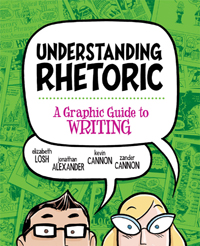
 In March 2013, Elizabeth Losh, Jonathan Alexander, Kevin Cannon, and Zander Cannon published a textbook titled Understanding Rhetoric: A Graphic Guide to Writing, through Bedford/St. Martin’s Press. Totaling 305 pages, including the title pages, contents, preface, introduction, body, glossary, index and afterword, the book is packed with information from the inside cover to the additional information for students on the last page. In many ways this text is as densely packed and layered with information as any Heidegger text, but in a much more enjoyable and digestible package.
In March 2013, Elizabeth Losh, Jonathan Alexander, Kevin Cannon, and Zander Cannon published a textbook titled Understanding Rhetoric: A Graphic Guide to Writing, through Bedford/St. Martin’s Press. Totaling 305 pages, including the title pages, contents, preface, introduction, body, glossary, index and afterword, the book is packed with information from the inside cover to the additional information for students on the last page. In many ways this text is as densely packed and layered with information as any Heidegger text, but in a much more enjoyable and digestible package.
Though graphic novels are used as resources in writing, communication, and literary courses and scholarship, the only notable uses of the graphic novel format for scholarly work prior to this book were by Scott McCloud in his works Making Comics (McCloud, 2006), Reinventing Comics (McCloud, 2000), and Understanding Comics (McCloud, 1994). Another widely distributed work, though not scholarly, which made use of the graphic novel format, was The 9/11 Report: A Graphic Adaptation by Sid Jacobson and Ernie Colon (2006). Losh and comrades have taken the textbook into a new medium by creating a textbook on writing in the format of a graphic novel.
While it might be easy to dismiss the comic book as a nonacademic medium, “many writing instructors have begun using comics in the composition classroom to engage students with writing that is both textually and visually rich” (Losh, Alexander, Cannon, & Cannon, 2013, p. vi). Yet, though graphic novels have been used to engage, they are seldom textbooks in themselves. With the growth of multimodal rhetoric in academia, it is about time to take a new look at the genre as a mode of serious discourse and a powerful pedagogical tool. With no more adieu, let’s get out of the kiddy comics and dive into the graphic novel.